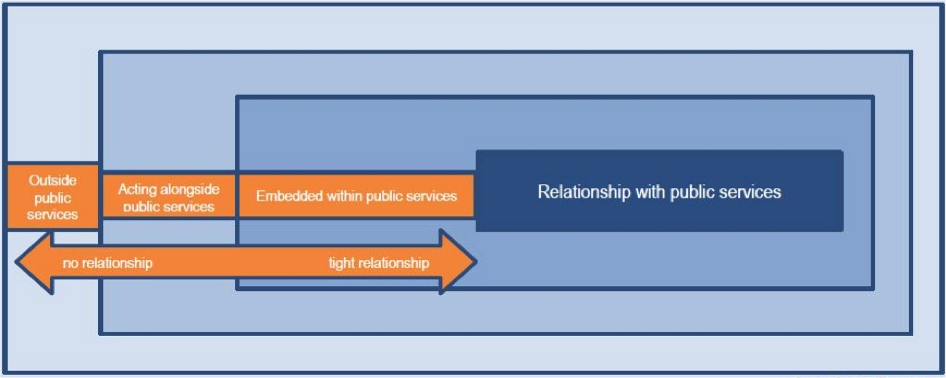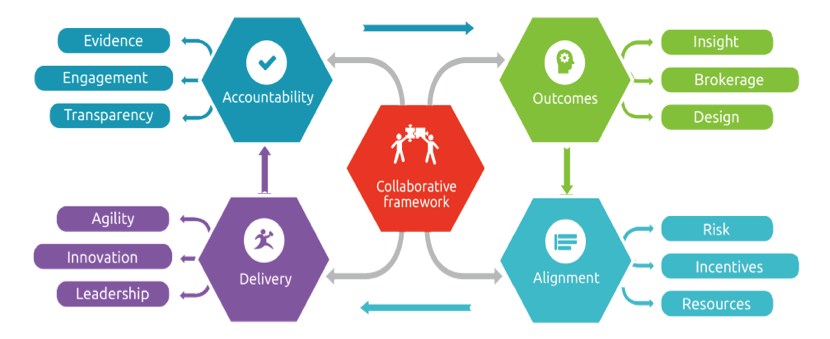
The outcomes of the “European and US stories of CHANGE!” Breakout Session
We often tend to speak about community engagement like a mantra, but it is indeed the core element of collaborative public policies. Before rejecting the idea to engage citizens into the service delivery, because it seems too hard, we need to think critically about the way in which public services are currently delivered and how effective they are at meeting people’s needs. Perhaps it is possible to improve collaboration? At URBACT City Festival 2018, the joint workshop of the CHANGE! network and Cities of Service offered some solutions by highlighting a theoretical method: CHANGE! that partner cities found useful and a concrete initiative hundreds of US cities appreciate, now reaching Europe.
People-powered services: one answer to the crisis
There has always been a significant amount of voluntary work and social action embedded into public services, but there is far more potential. More attention has been made to collaborative services after the economic crisis, when public services confronted increased demands and austerity measures. Cities and local public agencies all around Europe faced a challenge: how to provide more and better public services by using fewer funds? One possible answer is to create more personal and responsive services. For this, we need better engagement. Engaging citizens in public services means learning how to unlock and embed their knowledge, skills and personal experience in or alongside public services. This is called “people-powered” services or simply social action or people-helping-people referring to various activities undertaken voluntarily to benefit others.
Mobilising people to help each other (in or alongside public services) should be the core organising principle for public services to “do more for less” in the future. Besides fostering e-governance and digital solutions, people-powered services seem an efficient answer to the above challenge. It is also in line with what researchers say: it is high time to change the traditional welfare state to relational welfare as it is often inefficient and unresponsive to needs, as well as expensive. People-powered services organised in or alongside public services can improve the quality of the service provided, reduce demand for services, increase preventative activity, drive up innovation and productivity of the public service, improve outcomes and ultimately help build stronger communities.
So the question is how to better collaborate?
When top-down systems meet grass-root initiatives
People-powered services might be rather simple. CHANGE! partner cities got to know several preventive schemes like the great Family by Family initiative, which is a perfect example to highlight the power of peer support, but also the way how the state nurtured to scale a social action innovation up. The Australian Centre for Social Innovation developed this new approach to reduce the number of children being taken into the child protection system and to help families before they reached crisis point.
“Family by Family provides peer support to families as they seek to make the changes they have identified as needed, and to sustain those changes. Sharing Families are those who have come through difficult times successfully and are prepared to share their experience. Seeking Families are those looking for support to change some aspect of their family relationships. Family by Family brings Sharing Families and Seeking Families together, with a focus on helping families to stay together and flourish. The Family by Family approach seeks to intervene before the state must. By having professional support in the background, and families at the forefront, Family by Family uses peer support and mentoring to empower families to change” (Emma Clarence: People Helping People – Five Case Studies).
While drafting the Integrated Action Plans (IAP) CHANGE! partner cities were less interested in adapting concrete examples than setting the way for collaborative policy creation in general. Instead of starting from the bottom by planning peer-support activities, for example, many CHANGE! partner cities used the opportunity to break the ice with key stakeholders, find change agents locally and build up a common knowledge around the theme. At these partner cities the IAPs follow the process started, establishing and continuing the operation of a learning platform to boost collaborative policy-making, including public services and people-powered services in the long run.
Collaboration does not happen by accident, public agencies including cities should start this process from top-down by preparing a framework in which residents feel encouraged and empowered. Thus, collaboration might start and flourish, and meanwhile public agencies are challenged by grass root ideas initiated thus learning how to innovate. So collaborative (co-designed and co-managed) services require “collective action from players on both sides on the contract, built on social capital, trust and shared values that allow and enable citizens to be co-productive agents in the relationship” (Dr Henry Kippin: Collaborative capacity in public service delivery – Towards a framework for practice).
For this exercise, CHANGE! partner cities used the Collaborative Framework, originally published by Collaborate, a UK-based think-tank in the United Nations Development Programme. It was followed by CHANGE! partner cities during both the exchange and learning- and Urbact Local Group activities. As the Collaborative Framework can be interpreted as a collection of parameters around collaboration, any local collaborative initiative can be analysed along the Framework. Indeed, we can witness the establishment of “social hubs” across Europe, that help stakeholders understand how design works in public services, and events inspire, mobilise and connect innovators who can change the way of traditional municipal thinking, all because innovation starts from the citizens’ experience. Through connecting innovators and collecting, prototyping and accelerating their ideas, these initiatives in the IAPs want to broaden municipal thinking.
During the different study visits organised within the CHANGE!, network partner cities analysed many different institutionalised top-down systems specifically related to stimulate collaboration in public services or policy making (just to name a few):
- We saw how Community Organisers in the UK, the WeEindhoven model in the Netherlands or round-tables and informal leaders in Forlì, Italy try to get a better insight of what local people really need in an informal way and through a truly equal role.
- We analysed how Gdańsk puts the end-user into the centre of the design process through Local Participatory Public Policy Creation and Implementation.
- We also learnt from SPICE Time Credits that incentivising local people to collaborate makes sense and it is possible to install such a collaborative tool by using a central model.
- We got to know the Centre for Social Action Innovation Fund at Nesta, London which is an institute to accelerate people-helping-people innovations across the UK.
- CHANGE! partner cities are also familiar with Co-operative Councils Innovation Network which has committed to putting engagement and democracy at the heart of their public service reform strategy. These councils are attempting to reshape commissioning and service provision through engaging more meaningfully with the community to co-design the services they receive.
- We studied how the Public Participation Network in Ireland facilitates the participation and representation of communities in a fair, equitable and transparent manner through the environmental, social inclusion & voluntary sectors on decision making bodies; how it strengthens the capacity of communities and voluntary groups to contribute positively to the community in which they reside/participate; how it provides information relevant to these sectors and acts as a hub around which information is distributed and received.
- Last but not least, we visited the Centre for Innovation in Aarhus efficiently stimulating and prototyping public service innovation within the organisation.
All in all, it seems that top-down structures established with the aim to simulate different aspects of collaboration have reason for existence and they can be efficient if managed well. Due to their size, cities are well-positioned to enable and facilitate people-helping-people initiatives. As the need for collaborative services increases, cities should provide local grants and consider transforming their local participatory budget schemes to support social action innovations to grow.
Why should individuals do the municipality’s job?
Engagement is the alpha and omega in collaborative public services, because the value of public services is realized when the end-users meet the system. The problem is that too often it is just a nice-to-have policy. But this is not just a theoretical question related to collaborative public services, but a burning issue in – for example – smart city strategies too. At a minimum, active engagement in collaborative services means that people are willing to give up their time to contribute to a debate about ways in which their services can be improved. At best people will take charge of the planning and co-creation of services. Engagement is always a two-way street where clear traffic signs are very much needed.

Joe Micheli, Head of Commissioning at City of York Council highlighted during the session that Cities of Service can be useful for any European cities, because when a city adopts the core principles of the model – leadership, deliberation, collaboration and results -, such evidence of impact and shared leadership becomes the norm and is difficult to “undo”. And Cities of Service, which requires a comprehensive co-design of public services in the frame of a service plan, focuses on high impact areas though meaningful partnerships and cross-sector collaboration to address city challenges, is a great tool to start such a difficult process.
It is not possible of course to “force out” engagement from the public, but there is a need for a top-down system enhancing engagement and collaboration in both sides. A system to create situations in which collaborative methods such as people-helping-people approaches can be better understood. This is indeed a sensitive game. Values such as democracy, openness, trust, tolerance, civic participation, social networks and the use of democratic institutions represent crucial socio-economic and cultural factors, which influence the dynamism of social innovation, open government initiatives and collaborative public services. More specifically, the trust among people and in public institutions and the level of voluntarism within the society mean the most important factors to be analysed while talking about collaborative policies.
And, because system learning needs time, we need municipalities indeed acting as matchmakers, and providing joint learning experience, just as many CHANGE! partner cities intend to do that through their action plan.
Furthermore, trust is the glue in collaborative practices and without taking it responsibly, the process of opening up public services can easily bump into negative attitudes which can block the whole process. This is the reason why small-scale symbolic projects (urban acupuncture) or quick wins are fundamental in this field too. And Cities of Service can generate such a symbolic power!

So just do it! People helping people is a powerful start, but not a panacea! It does not require a big public budget and strengthening social cohesion is always a good step forward!





